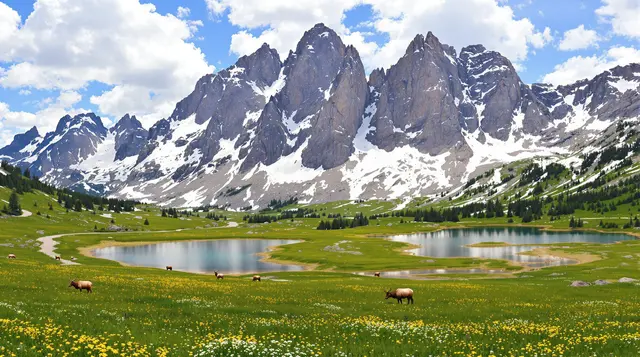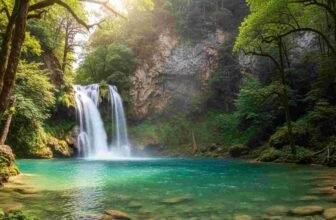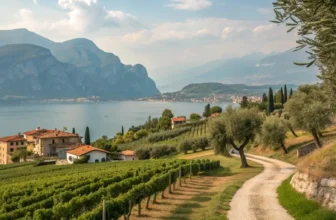
There’s something magical about standing face-to-face with nature’s wildest wonders. The rush of locking eyes with a majestic animal, the thrill of hearing the rustle of unseen creatures, or the serenity of watching wildlife in their element—it’s an experience that transforms you.
In a world where screens dominate, these moments remind us of what it feels like to truly connect. Imagine places where such encounters aren’t just rare—they’re guaranteed.
Whether it’s raw power, quiet beauty, or untamed freedom, these parks offer it all. Get ready to explore destinations that will awaken your adventurous spirit and leave you in awe.
1. Zion National Park

Nestled in the heart of Utah, Zion National Park feels like stepping into another world. Towering sandstone cliffs painted in hues of red, pink, and cream create a surreal backdrop, and the Virgin River winds its way through the canyon, adding a touch of serenity to the rugged beauty. I remember my first visit to Zion, standing at the edge of Angels Landing—heart pounding—not just from the view but the thrill of getting there. It’s not just the landscape that captivates you; it’s the feeling of being completely immersed in nature’s grandeur.
Wildlife encounters here are frequent. Keep an eye out for desert bighorn sheep navigating rocky ledges like pros. You’ll also spot mule deer grazing in the meadows and, if you’re lucky, the elusive California condor soaring above. The park’s varied habitats make it a haven for wildlife enthusiasts. Plus, the narrows of the Virgin River are an adventure on their own, offering a refreshing walk-through shallow water with canyon walls rising dramatically on both sides.
Zion is not just about the big moments; even the small details amaze me. From tiny lizards darting across the trail to the sweet aroma of juniper trees, the park charms all your senses. Spring and fall are the best seasons to visit, with pleasant weather and fewer crowds, but the park’s beauty knows no off-season.
Relevant Information:
- Best Months to Visit: April to May, September to November
- Popular Trails: Angels Landing, The Narrows, Emerald Pools
- Wildlife to Look For: Desert bighorn sheep, mule deer, California condors
- Pro Tip: Arrive early to catch the sunrise at Canyon Overlook Trail—it’s magical and avoids crowds.
2. Acadia National Park

Tucked away on Maine’s rugged coastline, Acadia National Park is where the mountains meet the sea. Imagine waking up to the sound of waves crashing against granite cliffs, with seabirds calling overhead—it’s like something out of a dream. One of the park’s most iconic spots is Cadillac Mountain, where you can catch the first sunrise in the U.S. during certain months. Watching the sun light up the Atlantic from this vantage point feels like pure magic.
Wildlife thrives in Acadia’s diverse ecosystems. From playful otters along the shoreline to bald eagles soaring majestically above, there’s always something to marvel at. The park is also home to harbor seals, foxes, and even the occasional moose. Strolling along the famous Jordan Pond Path, you might also spot loons gliding across the water’s surface, their haunting calls adding to the park’s mystique.
What I love most about Acadia is its accessibility. Whether you’re hiking up trails like Beehive or Precipice or enjoying a leisurely drive along the Park Loop Road, there’s an adventure for every type of traveler. And the quaint nearby town of Bar Harbor is the cherry on top, offering cozy spots for lobster rolls after a day of exploring.
Relevant Information:
- Best Months to Visit: June to October
- Popular Trails: Cadillac Mountain, Jordan Pond Path, Beehive Trail
- Wildlife to Look For: Harbor seals, bald eagles, loons
- Pro Tip: Visit during the fall to witness the stunning foliage—it’s unforgettable.
3. Joshua Tree National Park

Joshua Tree National Park, located in Southern California, is like stepping into a surrealist painting. The namesake Joshua trees stand tall and twisted, their spiky silhouettes stark against a sky that seems to stretch forever. And then there are the rocks—massive, otherworldly formations perfect for climbing or just marveling at. I once spent a moonlit evening here, and the silence, broken only by the occasional coyote call, was profoundly calming.
Wildlife is as unique as the landscape. During the day, you might spot jackrabbits or desert tortoises, while at night, kangaroo rats and kit foxes come out to play. The park is also a birder’s paradise, with roadrunners zipping across trails and golden eagles soaring high above. And the night sky? It’s a stargazer’s dream. With minimal light pollution, you’ll feel like you can almost touch the Milky Way.
Despite its desert environment, Joshua Tree was surprised by its variety. From blooming wildflowers in spring to cozy campfires under winter’s chilly stars, there’s no bad time to visit. Just be sure to pack plenty of water and sunscreen—it’s the desert, after all!
Relevant Information:
- Best Months to Visit: March to May, October to November
- Popular Trails: Hidden Valley, Barker Dam, Ryan Mountain
- Wildlife to Look For: Jackrabbits, desert tortoises, roadrunners
- Pro Tip: Stay overnight to experience the mesmerizing stargazing opportunities.
4. Redwood National and State Parks

Walking among the towering giants of Redwood National and State Parks is a humbling experience. These ancient trees, some over 2,000 years old, make you feel both small and deeply connected to nature. There’s a quiet magic here, where sunlight filters through the canopy and creates a peaceful ambiance. One of my favorite memories is hiking the Fern Canyon Trail, where moss-covered walls make you feel like you’re in a prehistoric world.
Wildlife here is just as impressive as the trees. Roosevelt elk roam the meadows, banana slugs crawl along the forest floor, and black bears make occasional appearances. The coastal sections of the park offer even more variety, with tide pools teeming with sea stars, anemones, and crabs.
What makes this park special is its blend of forest and coastline. You can spend the morning surrounded by redwoods and the afternoon walking along sandy beaches, all within the same park. The diverse ecosystem is a testament to nature’s resilience and beauty.
Relevant Information:
- Best Months to Visit: May to September
- Popular Trails: Fern Canyon, Lady Bird Johnson Grove, Tall Trees Trail
- Wildlife to Look For: Roosevelt elk, banana slugs, black bears
- Pro Tip: Explore at dawn to enjoy the park’s tranquility before the crowds arrive.
5. Canyonlands National Park

Canyonlands National Park in Utah is like a natural masterpiece, with vast canyons, towering mesas, and vibrant colors that shift with the light. Divided into four distinct districts, the Island in the Sky section is the most accessible and offers breathtaking overlooks that make you feel like you’re standing on the world’s edge. One of my most vivid memories here is watching the sunrise from Mesa Arch, the soft morning light framing the arch like a fiery portal.
Wildlife is well-adapted to this harsh desert environment. If you’re lucky, you might catch glimpses of coyotes, desert cottontails, or even bobcats. The park is also home to countless bird species, from ravens to golden eagles. The rugged beauty of the park makes every wildlife sighting feel like a small miracle.
Canyonlands is perfect for adventurers. Whether you’re hiking, biking, or rafting along the Colorado River, there’s no shortage of ways to explore. Just be prepared for the dry climate—hydration and proper planning are essential for a safe and enjoyable visit.
Relevant Information:
- Best Months to Visit: March to May, September to November
- Popular Trails: Mesa Arch, Grand View Point, White Rim Trail
- Wildlife to Look For: Coyotes, desert cottontails, bobcats
- Pro Tip: Don’t miss the sunset at Green River Overlook—it’s a breathtaking experience.
6. Big Bend National Park

Big Bend National Park in Texas is a treasure trove of dramatic desert landscapes, towering canyons, and a winding river that defines the U.S.-Mexico border. The rugged beauty of the Chisos Mountains contrasts with the sprawling Chihuahuan Desert, offering a variety of terrains to explore. One unforgettable moment for me was kayaking along the Rio Grande, feeling dwarfed by the massive canyon walls on either side.
Wildlife encounters are part of the charm. You might see javelinas, roadrunners, and even black bears in the higher elevations of the Chisos Basin. At night, the park transforms into one of the best stargazing spots in the U.S., thanks to its remote location and minimal light pollution.
What makes Big Bend truly special is its remoteness. It’s not a park you stumble into; you plan to go there, and the effort pays off. The sense of solitude, coupled with breathtaking views, makes it an ideal escape from the hustle and bustle of daily life.
Relevant Information:
- Best Months to Visit: October to April
- Popular Trails: Lost Mine Trail, Santa Elena Canyon, Window Trail
- Wildlife to Look For: Javelinas, black bears, roadrunners
- Pro Tip: Visit during the spring to see the desert bloom with vibrant wildflowers.
7. Sequoia and Kings Canyon National Parks

These twin parks in California are famous for their giant sequoias, including General Sherman, the largest tree on Earth. Walking through the Giant Forest feels like being in a cathedral built by nature. My highlight? Standing at the base of General Sherman and realizing just how small we are in the grand scheme of things.
Wildlife here is abundant. You’ll likely spot mule deer, black bears, and Steller’s jays. The parks also feature roaring rivers, peaceful meadows, and granite peaks, making them a paradise for outdoor lovers. Kings Canyon, often overshadowed by Sequoia, is just as impressive with its glacial valleys and dramatic cliffs.
Beyond the trees, these parks offer a blend of serenity and adventure. Whether you’re taking a stroll or challenging yourself with a strenuous hike, the parks cater to every level of explorer.
Relevant Information:
- Best Months to Visit: June to September
- Popular Trails: Moro Rock, Congress Trail, Mist Falls Trail
- Wildlife to Look For: Black bears, mule deer, Steller’s jays
- Pro Tip: Bring a jacket, even in summer—it gets chilly under the sequoias.
8. Rocky Mountain National Park

In Colorado’s Rocky Mountain National Park, the rugged peaks and alpine meadows create a picturesque landscape that feels like it belongs on a postcard. The Trail Ridge Road, one of the highest continuous paved roads in the U.S., offers jaw-dropping views at every turn. One of my most cherished memories here was spotting a herd of elk grazing peacefully in a meadow.
Wildlife is a major draw, with opportunities to see elk, moose, and bighorn sheep in their natural habitat. The park is also home to smaller creatures like marmots and pikas, which add a playful touch to your visit. The changing seasons bring their charm, from wildflower blooms in summer to snow-draped landscapes in winter.
Hiking is the park’s main attraction, with trails that range from easy strolls to challenging climbs. Whether you’re trekking to Emerald Lake or exploring the Bear Lake Corridor, there’s no shortage of breathtaking scenery.
Relevant Information:
- Best Months to Visit: June to September
- Popular Trails: Bear Lake, Emerald Lake, Longs Peak
- Wildlife to Look For: Elk, moose, bighorn sheep
- Pro Tip: Arrive early to beat the crowds and catch wildlife during their most active hours.
9. Cuyahoga Valley National Park

Nestled in Ohio, Cuyahoga Valley National Park surprises visitors with its lush greenery, cascading waterfalls, and historic charm. Unlike the rugged grandeur of some western parks, Cuyahoga feels intimate and inviting. One of my favorite experiences here was riding the Cuyahoga Valley Scenic Railroad, soaking in the beauty of the rolling hills and the namesake river.
The park is a haven for wildlife, with sightings of beavers, great blue herons, and white-tailed deer being common. The wetlands, woodlands, and meadows create a diverse ecosystem that’s a joy to explore. Don’t miss Brandywine Falls, a stunning 65-foot waterfall that’s perfect for photography.
Cuyahoga’s proximity to urban areas makes it an accessible getaway. Whether you’re hiking, biking, or just picnicking by the river, the park offers a serene escape from city life.
Relevant Information:
- Best Months to Visit: April to October
- Popular Trails: Ledges Trail, Brandywine Falls, Towpath Trail
- Wildlife to Look For: Beavers, white-tailed deer, great blue herons
- Pro Tip: Visit in the fall to enjoy the vibrant autumn colors.
10. Bryce Canyon National Park

Bryce Canyon in Utah is a place like no other, with its unique hoodoo formations creating an almost alien landscape. The fiery red and orange spires seem to glow during sunrise and sunset, making those times the best for photography. Hiking through the Navajo Loop Trail and standing at Sunset Point were moments that left me speechless.
Wildlife here is fascinating. You might spot prairie dogs, peregrine falcons, and even pronghorn antelope in the open areas. Despite its arid appearance, the park is teeming with life, and its high elevation means cooler temperatures even in summer.
What makes Bryce Canyon truly unique is its compact size. You can see many of its highlights in a day or two, making it a perfect destination for short trips. However, its beauty will make you want to stay longer.
Relevant Information:
- Best Months to Visit: May to September
- Popular Trails: Navajo Loop, Queen’s Garden, Bryce Amphitheater
- Wildlife to Look For: Prairie dogs, peregrine falcons, pronghorn antelope
- Pro Tip: Dress in layers—the high elevation means chilly mornings and evenings.
11. Everglades National Park

The Everglades in Florida is a sprawling, subtropical wilderness unlike any other. Picture endless expanses of sawgrass, dotted with hammocks of trees, and waterways teeming with life. It’s a park where the journey feels as vital as the destination—whether you’re paddling through mangrove tunnels or walking along the Anhinga Trail, there’s a sense of discovery around every corner. On my visit, an alligator lazing just feet away from the boardwalk was both thrilling and humbling.
Wildlife is the Everglades’ calling card. It’s a haven for American alligators, manatees, and wading birds, with frequent sightings guaranteed. The park is also the only place in the world where both alligators and crocodiles coexist. But it’s not just about the big animals; even the smallest creatures, like dragonflies and frogs, add their charm to the landscape.
This park is a love letter to biodiversity, offering glimpses of ecosystems that feel untouched by time. Whether you’re an avid birder or simply looking for an unforgettable boat ride, the Everglades never fail to deliver.
Relevant Information:
- Best Months to Visit: December to April (dry season)
- Popular Activities: Airboat tours, kayaking, Anhinga Trail
- Wildlife to Look For: Alligators, manatees, wading birds
- Pro Tip: Take a ranger-led boat tour to access the park’s hidden gems.
12. Olympic National Park

Olympic National Park in Washington feels like stepping into multiple worlds. From rugged coastlines and moss-draped rainforests to alpine peaks, it’s a place where diversity reigns supreme. My favorite memory? Walking through the Hoh Rain Forest, where everything seemed alive—the trees, the moss, even the air.
Wildlife thrives here in abundance. Roosevelt elk wander the forests, river otters frolic in streams, and gray whales can sometimes be spotted along the coast. The park’s range of habitats means you’re likely to encounter something amazing, no matter where you explore. And don’t overlook the smaller creatures, like banana slugs and colorful birds, that make this ecosystem so vibrant.
The park’s unique blend of ecosystems makes it a paradise for nature lovers. Whether you’re scaling Hurricane Ridge or dipping your toes into the Pacific at Rialto Beach, Olympic offers a feast for the senses.
Relevant Information:
- Best Months to Visit: June to September
- Popular Trails: Hoh Rain Forest Trail, Hurricane Ridge, Rialto Beach
- Wildlife to Look For: Roosevelt elk, gray whales, river otters
- Pro Tip: Pack for all types of weather—the park’s varied climates can surprise you.
13. Badlands National Park

The stark beauty of Badlands National Park in South Dakota is a sight to behold. It’s a land of striking contrasts, where jagged rock formations meet expansive prairies. I’ll never forget standing at one of the overlooks, watching the sun dip below the horizon and casting long shadows over the surreal landscape.
Wildlife in the Badlands is surprisingly rich. From bison and prairie dogs to bighorn sheep, the park teems with life despite its rugged appearance. Look closer, and you might even spot swift foxes darting through the grass or golden eagles riding thermals high above.
The Badlands feels like a place frozen in time, its fossil-rich formations telling stories of ancient ecosystems. For those seeking solitude and raw natural beauty, it’s a destination that stays with you long after you’ve left.
Relevant Information:
- Best Months to Visit: April to June, September to October
- Popular Trails: Notch Trail, Door Trail, Castle Trail
- Wildlife to Look For: Bison, prairie dogs, bighorn sheep
- Pro Tip: Stop by at night for stunning stargazing—the dark skies are mesmerizing.
14. Isle Royale National Park

Isle Royale National Park, located in the middle of Lake Superior, feels like a world apart. Accessible only by boat or seaplane, it’s a remote wilderness that rewards those willing to make the journey. One memory etched in my mind is hiking through the Greenstone Ridge Trail, surrounded by the deep blues of the lake and the lush greens of the forest.
This island sanctuary is home to moose, wolves, and red foxes, with wildlife encounters feeling even more special thanks to the park’s isolation. The surrounding waters teem with fish, and the occasional sight of a bald eagle adds to the magic. If you’re looking for tranquility, you’ll find it here, far from the hustle and bustle of everyday life.
Whether you’re kayaking along the coastline or camping under a blanket of stars, Isle Royale offers a sense of peace and connection to nature that’s hard to match. Just be prepared—it’s as wild as it is beautiful.
Relevant Information:
- Best Months to Visit: June to September
- Popular Trails: Greenstone Ridge Trail, Minong Ridge Trail
- Wildlife to Look For: Moose, wolves, bald eagles
- Pro Tip: Pack smart—this remote park requires you to be self-sufficient.
15. Katmai National Park & Preserve

If you’re looking for a wildlife encounter that borders on the extraordinary, Katmai National Park in Alaska is the place to be. Famous for its brown bears fishing for salmon at Brooks Falls, this park offers an experience like no other. Watching a bear swipe a leaping salmon from midair is something I’ll never forget—it’s nature’s drama at its finest.
Katmai’s remoteness adds to its allure. Beyond the bears, you’ll find pristine lakes, active volcanoes, and a vast wilderness that feels untouched. The Valley of Ten Thousand Smokes, with its otherworldly landscape created by a volcanic eruption, is another must-see.
Whether you’re a wildlife photographer or an adventurer seeking a true wilderness escape, Katmai is the ultimate destination. It’s raw, untamed, and profoundly humbling.
Relevant Information:
- Best Months to Visit: June to September
- Popular Activities: Bear viewing at Brooks Falls, exploring Valley of Ten Thousand Smokes
- Wildlife to Look For: Brown bears, salmon, foxes
- Pro Tip: Book a guided bear-viewing tour for a safe and unforgettable experience.






